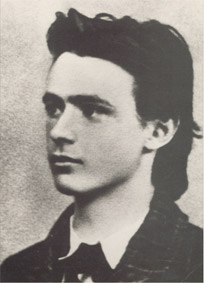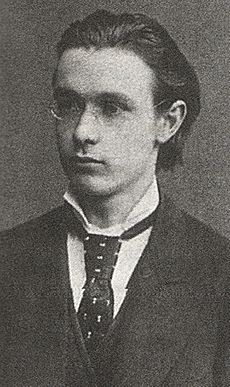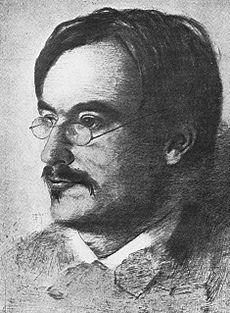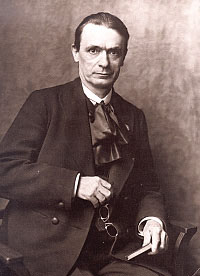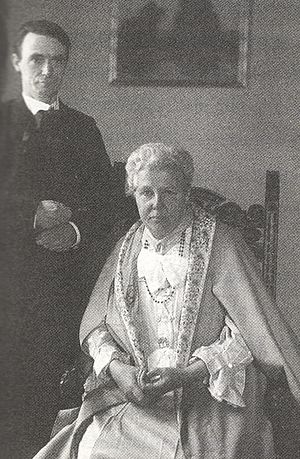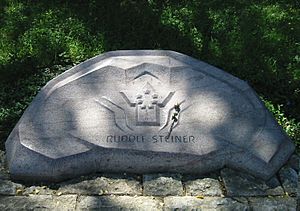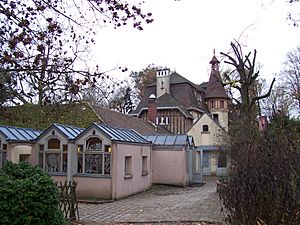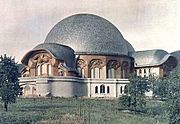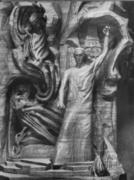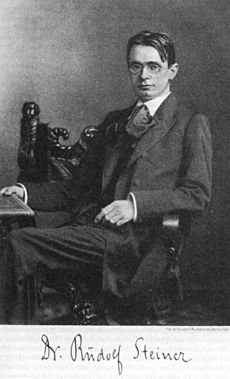Rudolf Steiner facts for kids
Quick facts for kids
Rudolf Steiner
|
|
|---|---|
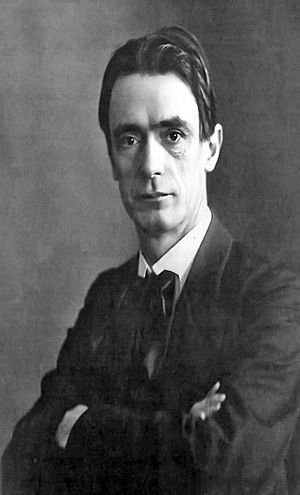
Steiner c. 1905
|
|
| Born |
Rudolf Joseph Lorenz Steiner
27 February 1861 Murakirály, Kingdom of Hungary, Austrian Empire (now Donji Kraljevec, Croatia)
|
| Died | 30 March 1925 (aged 64) Dornach, Switzerland
|
| Education | Vienna Institute of Technology University of Rostock (PhD, 1891) |
| Spouse(s) |
Anna Eunicke
(m. 1899; died 1911)Marie Steiner-von Sivers
(m. 1914) |
| Part of a series on |
| Anthroposophy |
|---|
| General |
|
| Anthroposophically inspired work |
|
| Philosophy |
|
Rudolf Joseph Lorenz Steiner (27 or 25 February 1861 – 30 March 1925) was an Austrian occultist, social reformer, architect, esotericist, and claimed clairvoyant. Steiner gained initial recognition at the end of the nineteenth century as a literary critic and published works including The Philosophy of Freedom. At the beginning of the twentieth century he founded an esoteric spiritual movement, anthroposophy, with roots in German idealist philosophy and theosophy. His teachings have been described as similar to Christian Gnosticism (for heresiologists it is little doubt that these are neognosticism). Many of his ideas are pseudoscientific. He was also prone to pseudohistory.
In the first, more philosophically oriented phase of this movement, Steiner attempted to find a synthesis between science and spirituality. His philosophical work of these years, which he termed "spiritual science", sought to apply what he saw as the clarity of thinking characteristic of Western philosophy to spiritual questions, differentiating this approach from what he considered to be vaguer approaches to mysticism. In a second phase, beginning around 1907, he began working collaboratively in a variety of artistic media, including drama, dance and architecture, culminating in the building of the Goetheanum, a cultural centre to house all the arts. In the third phase of his work, beginning after World War I, Steiner worked on various ostensibly applied projects, including Waldorf education, biodynamic agriculture, and anthroposophical medicine.
Steiner advocated a form of ethical individualism, to which he later brought a more explicitly spiritual approach. He based his epistemology on Johann Wolfgang Goethe's world view, in which "thinking…is no more and no less an organ of perception than the eye or ear. Just as the eye perceives colours and the ear sounds, so thinking perceives ideas." A consistent thread that runs through his work is the goal of demonstrating that there are no limits to human knowledge.
Biography
Childhood and education
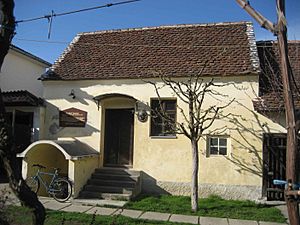
Steiner's father, Johann(es) Steiner (1829–1910), left a position as a gamekeeper in the service of Count Hoyos in Geras, northeast Lower Austria to marry one of the Hoyos family's housemaids, Franziska Blie (1834 Horn – 1918, Horn), a marriage for which the Count had refused his permission. Johann became a telegraph operator on the Southern Austrian Railway, and at the time of Rudolf's birth was stationed in Murakirály (Kraljevec) in the Muraköz region of the Kingdom of Hungary, Austrian Empire (present-day Donji Kraljevec in the Međimurje region of northernmost Croatia). In the first two years of Rudolf's life, the family moved twice, first to Mödling, near Vienna, and then, through the promotion of his father to stationmaster, to Pottschach, located in the foothills of the eastern Austrian Alps in Lower Austria.
Steiner entered the village school, but following a disagreement between his father and the schoolmaster, he was briefly educated at home. In 1869, when Steiner was eight years old, the family moved to the village of Neudörfl and in October 1872 Steiner proceeded from the village school there to the realschule in Wiener Neustadt.
In 1879, the family moved to Inzersdorf to enable Steiner to attend the Vienna Institute of Technology, where he enrolled in courses in mathematics, physics, chemistry, botany, zoology, and mineralogy and audited courses in literature and philosophy, on an academic scholarship from 1879 to 1883, where he completed his studies and the requirements of the Ghega scholarship satisfactorily. In 1882, one of Steiner's teachers, Karl Julius Schröer, suggested Steiner's name to Joseph Kürschner, chief editor of a new edition of Goethe's works, who asked Steiner to become the edition's natural science editor, a truly astonishing opportunity for a young student without any form of academic credentials or previous publications.
Before attending the Vienna Institute of Technology, Steiner had studied Kant, Fichte and Schelling.
Early spiritual experiences
When he was nine years old, Steiner believed that he saw the spirit of an aunt who had died in a far-off town, asking him to help her at a time when neither he nor his family knew of the woman's death. Steiner later related that as a child, he felt "that one must carry the knowledge of the spiritual world within oneself after the fashion of geometry ... [for here] one is permitted to know something which the mind alone, through its own power, experiences. In this feeling I found the justification for the spiritual world that I experienced ... I confirmed for myself by means of geometry the feeling that I must speak of a world 'which is not seen'."
Steiner believed that at the age of 15 he had gained a complete understanding of the concept of time, which he considered to be the precondition of spiritual clairvoyance. At 21, on the train between his home village and Vienna, Steiner met an herb gatherer, Felix Kogutzki, who spoke about the spiritual world "as one who had his own experience therein".
Writer and philosopher
In 1888, as a result of his work for the Kürschner edition of Goethe's works, Steiner was invited to work as an editor at the Goethe archives in Weimar. Steiner remained with the archive until 1896. As well as the introductions for and commentaries to four volumes of Goethe's scientific writings, Steiner wrote two books about Goethe's philosophy: The Theory of Knowledge Implicit in Goethe's World-Conception (1886), which Steiner regarded as the epistemological foundation and justification for his later work, and Goethe's Conception of the World (1897). During this time he also collaborated in complete editions of the works of Arthur Schopenhauer and the writer Jean Paul and wrote numerous articles for various journals.
In 1891, Steiner received a doctorate in philosophy at the University of Rostock, for his dissertation discussing Fichte's concept of the ego, submitted to Heinrich von Stein, whose Seven Books of Platonism Steiner esteemed. Steiner's dissertation was later published in expanded form as Truth and Knowledge: Prelude to a Philosophy of Freedom, with a dedication to Eduard von Hartmann. Two years later, in 1894, he published Die Philosophie der Freiheit (The Philosophy of Freedom or The Philosophy of Spiritual Activity, the latter being Steiner's preferred English title), an exploration of epistemology and ethics that suggested a way for humans to become spiritually free beings. Steiner later spoke of this book as containing implicitly, in philosophical form, the entire content of what he later developed explicitly as anthroposophy.
In 1896, Steiner declined an offer from Elisabeth Förster-Nietzsche to help organize the Nietzsche archive in Naumburg. Her brother, Friedrich Nietzsche, was by that time non compos mentis. Förster-Nietzsche introduced Steiner into the presence of the catatonic philosopher; Steiner, deeply moved, subsequently wrote the book Friedrich Nietzsche, Fighter for Freedom.
In 1897, Steiner left the Weimar archives and moved to Berlin. He became part owner of, chief editor of, and an active contributor to the literary journal Magazin für Literatur, where he hoped to find a readership sympathetic to his philosophy. Many subscribers were alienated by Steiner's unpopular support of Émile Zola in the Dreyfus Affair and the journal lost more subscribers when Steiner published extracts from his correspondence with anarchist John Henry Mackay. Dissatisfaction with his editorial style eventually led to his departure from the magazine. In 1899, Steiner married Anna Eunicke; the couple separated several years later. Anna died in 1911.
Theosophical Society
In 1899, Steiner published an article, "Goethe's Secret Revelation", discussing the esoteric nature of Goethe's fairy tale The Green Snake and the Beautiful Lily. This article led to an invitation by the Count and Countess Brockdorff to speak to a gathering of Theosophists on the subject of Nietzsche. Steiner continued speaking regularly to the members of the Theosophical Society, becoming the head of its newly constituted German section in 1902 without ever formally joining the society. It was also in connection with this society that Steiner met and worked with Marie von Sivers, who became his second wife in 1914. By 1904, Steiner was appointed by Annie Besant to be leader of the Theosophical Esoteric Society for Germany and Austria. In 1904, Eliza, the wife of Helmuth von Moltke the Younger, became one of his favourite scholars. Through Eliza, Steiner met Helmuth, who served as the Chief of the German General Staff from 1906 to 1914.
In contrast to mainstream Theosophy, Steiner sought to build a Western approach to spirituality based on the philosophical and mystical traditions of European culture. The German Section of the Theosophical Society grew rapidly under Steiner's leadership as he lectured throughout much of Europe on his spiritual science. During this period, Steiner maintained an original approach, replacing Madame Blavatsky's terminology with his own, and basing his spiritual research and teachings upon the Western esoteric and philosophical tradition. This and other differences, in particular Steiner's vocal rejection of Leadbeater and Besant's claim that Jiddu Krishnamurti was the vehicle of a new Maitreya, or world teacher, led to a formal split in 1912–13, when Steiner and the majority of members of the German section of the Theosophical Society broke off to form a new group, the Anthroposophical Society. Steiner took the name "Anthroposophy" from the title of a work of the Austrian philosopher Robert von Zimmermann, published in Vienna in 1856. Despite his departure from the Theosophical Society, Steiner maintained his interest in Theosophy throughout his life.
Anthroposophical Society and its cultural activities
The Anthroposophical Society grew rapidly. Fueled by a need to find an artistic home for their yearly conferences, which included performances of plays written by Edouard Schuré and Steiner, the decision was made to build a theater and organizational center. In 1913, construction began on the first Goetheanum building, in Dornach, Switzerland. The building, designed by Steiner, was built to a significant part by volunteers. Steiner moved from Berlin to Dornach in 1913 and lived there to the end of his life.
Steiner's lecture activity expanded enormously with the end of the war. Most importantly, from 1919 on Steiner began to work with other members of the society to found numerous practical institutions and activities, including the first Waldorf school, founded that year in Stuttgart, Germany. On New Year's Eve, 1922–1923, the Goetheanum burned to the ground; contemporary police reports indicate arson as the probable cause. Steiner immediately began work designing a second Goetheanum building - this time made of concrete instead of wood - which was completed in 1928, three years after his death.
At a "Foundation Meeting" for members held at the Dornach center during Christmas 1923, Steiner founded the School of Spiritual Science. This school, which was led by Steiner, initially had sections for general anthroposophy, education, medicine, performing arts (eurythmy, speech, drama and music), the literary arts and humanities, mathematics, astronomy, science, and visual arts. Later sections were added for the social sciences, youth and agriculture. The School of Spiritual Science included meditative exercises given by Steiner.
Political engagement and social agenda
Steiner became a well-known and controversial public figure during and after World War I. In response to the catastrophic situation in post-war Germany, he proposed extensive social reforms through the establishment of a Threefold Social Order in which the cultural, political and economic realms would be largely independent. Steiner argued that a fusion of the three realms had created the inflexibility that had led to catastrophes such as World War I. In connection with this, he promoted a radical solution in the disputed area of Upper Silesia, claimed by both Poland and Germany. His suggestion that this area be granted at least provisional independence led to his being publicly accused of being a traitor to Germany.
Steiner opposed Wilson's proposal to create new European nations based around ethnic groups, which he saw as opening the door to rampant nationalism.
Attacks, illness, and death
The National Socialist German Workers Party gained strength in Germany after the First World War. In 1919, a political theorist of this movement, Dietrich Eckart, attacked Steiner and suggested that he was a Jew. In 1921, Adolf Hitler attacked Steiner on many fronts, including accusations that he was a tool of the Jews, while other nationalist extremists in Germany called for a "war against Steiner". That same year, Steiner warned against the disastrous effects it would have for Central Europe if the National Socialists came to power. In 1922 a lecture Steiner was giving in Munich was disrupted when stink bombs were let off and the lights switched out, while people rushed the stage apparently attempting to attack Steiner, who exited safely through a back door. Unable to guarantee his safety, Steiner's agents cancelled his next lecture tour. The 1923 Beer Hall Putsch in Munich led Steiner to give up his residence in Berlin, saying that if those responsible for the attempted coup (Hitler's Nazi party) came to power in Germany, it would no longer be possible for him to enter the country.
In reality, Steiner had both enemies and loyal supporters in the upper echelons of the Nazi regime. Staudenmaier speaks of the "polycratic party-state apparatus", so Nazism's approach to Anthroposophy was not characterized by monolithic ideological unity.
From 1923 on, Steiner showed signs of increasing frailness and illness. He nonetheless continued to lecture widely, and even to travel; especially towards the end of this time, he was often giving two, three or even four lectures daily for courses taking place concurrently. Many of these lectures focused on practical areas of life such as education.
Increasingly ill, he held his last lecture in late September, 1924. He continued work on his autobiography during the last months of his life; he died at Dornach on 30 March 1925.
Steiner has financed the publication of the book Die Entente-Freimaurerei und der Weltkrieg (1919) by Karl Heise; Steiner also wrote the foreword for the book, partly based upon his own ideas. The publication comprised a conspiracy theory according to whom World War I was a consequence of a collusion of Freemasons and Jews - still favorite scapegoats of the conspiracy theorists - their purpose being the destruction of Germany. The writing was later enthusiastically received by the Nazi Party. According to Dick Taverne Steiner was a Nazi (i.e. a member of the NSDAP).
Towards the end of Steiner's life and after his death, there were massive defamatory press attacks mounted on him by early Nazi Party leaders (including Adolf Hitler) and other right-wing nationalists. These criticized Steiner's thought and anthroposophy as being incompatible with Nazi racial ideology, and charged him with being influenced by his close connections with Jews and even (falsely) that he himself was Jewish. But Rudolf Hess, the adjunct Führer, was a patron of Anthroposophy and of Waldorf schools and a staunch defender of Steiner's biodynamic agriculture. When Hess defected to UK, their most powerful protector was gone, but Anthroposophists were still not left without supporters among higher-placed Nazis. According to Tommy Wieringa, a Dutch writer who grew among Anthroposophists, commenting upon an essay by the Anthroposophist Désanne van Brederode, Hess and Heinrich Himmler saw Steiner as their kindred spirit.
The Third Reich had banned almost all esoteric organizations, pretending that these are controlled by Jews. The truth was that while Anthroposophists complained of bad press, they were to a surprising extent let be by the Nazi regime, "including outspokenly supportive pieces in the Völkischer Beobachter". Ideological purists from Sicherheitsdienst argued largely in vain against Anthroposophy. According to Staudenmaier, "The prospect of unmitigated persecution was held at bay for years in a tenuous truce between pro-anthroposophical and anti-anthroposophical Nazi factions."
Marie Steiner-von Sivers, Guenther Wachsmuth, and Albert Steffen, had publicly expressed sympathy for the Nazi regime since its beginnings; led by such sympathies of their leadership, the Swiss and German Anthroposophical organizations chose for a path conflating accommodation with collaboration, which in the end ensured that while the Nazi regime hunted the esoteric organizations, Gentile Anthroposophists from Nazi Germany and countries occupied by it were let be to a surprising extent. Of course they had some setbacks from the enemies of Anthroposophy among the upper echelons of the Nazi regime, but Anthroposophists also had loyal supporters among them, so overall Gentile Anthroposophists were not badly hit by the Nazi regime.
Spiritual research
Steiner first began speaking publicly about spiritual experiences and phenomena in his 1899 lectures to the Theosophical Society. By 1901 he had begun to write about spiritual topics, initially in the form of discussions of historical figures such as the mystics of the Middle Ages. By 1904 he was expressing his own understanding of these themes in his essays and books, while continuing to refer to a wide variety of historical sources.
Steiner aimed to apply his training in mathematics, science, and philosophy to produce rigorous, verifiable presentations of those experiences. He believed that through freely chosen ethical disciplines and meditative training, anyone could develop the ability to experience the spiritual world, including the higher nature of oneself and others. Steiner believed that such discipline and training would help a person to become a more moral, creative and free individual – free in the sense of being capable of actions motivated solely by love. His philosophical ideas were affected by Franz Brentano, with whom he had studied, as well as by Fichte, Hegel, Schelling, and Goethe's phenomenological approach to science.
Steiner used the word Geisteswissenschaft (from Geist = mind or spirit, Wissenschaft = science), a term originally coined by Wilhelm Dilthey as a descriptor of the humanities, in a novel way, to describe a systematic ("scientific") approach to spirituality. Steiner used the term Geisteswissenschaft, generally translated into English as "spiritual science," to describe a discipline treating the spirit as something actual and real, starting from the premise that it is possible for human beings to penetrate behind what is sense-perceptible. He proposed that psychology, history, and the humanities generally were based on the direct grasp of an ideal reality, and required close attention to the particular period and culture which provided the distinctive character of religious qualities in the course of the evolution of consciousness. In contrast to William James' pragmatic approach to religious and psychic experience, which emphasized its idiosyncratic character, Steiner focused on ways such experience can be rendered more intelligible and integrated into human life.
Steiner proposed that an understanding of reincarnation and karma was necessary to understand psychology and that the form of external nature would be more comprehensible as a result of insight into the course of karma in the evolution of humanity. Beginning in 1910, he described aspects of karma relating to health, natural phenomena and free will, taking the position that a person is not bound by his or her karma, but can transcend this through actively taking hold of one's own nature and destiny. In an extensive series of lectures from February to September 1924, Steiner presented further research on successive reincarnations of various individuals and described the techniques he used for karma research.
Breadth of activity
After the First World War, Steiner became active in a wide variety of cultural contexts. He founded a number of schools, the first of which was known as the Waldorf school, which later evolved into a worldwide school network. He also founded a system of organic agriculture, now known as biodynamic agriculture, which was one of the first forms of modern organic farming. His work in medicine is based in pseudoscience and occult ideas. Even though his medical ideas led to the development of a broad range of complementary medications and supportive artistic and biographic therapies, they are considered ineffective by the medical community. Numerous homes for children and adults with developmental disabilities based on his work (including those of the Camphill movement) are found in Africa, Europe, and North America. His paintings and drawings influenced Joseph Beuys and other modern artists. His two Goetheanum buildings are considered significant examples of modern architecture, and other anthroposophical architects have contributed thousands of buildings to the modern scene.
Steiner's literary estate is broad. Steiner's writings, published in about forty volumes, include books, essays, four plays ('mystery dramas'), mantric verse, and an autobiography. His collected lectures, making up another approximately 300 volumes, discuss a wide range of themes. Steiner's drawings, chiefly illustrations done on blackboards during his lectures, are collected in a separate series of 28 volumes. Many publications have covered his architectural legacy and sculptural work.
Education
As a young man, Steiner was a private tutor and a lecturer on history for the Berlin Arbeiterbildungsschule, an educational initiative for working class adults. Soon thereafter, he began to articulate his ideas on education in public lectures, culminating in a 1907 essay on The Education of the Child in which he described the major phases of child development which formed the foundation of his approach to education. His conception of education was influenced by the Herbartian pedagogy prominent in Europe during the late nineteenth century, though Steiner criticized Herbart for not sufficiently recognizing the importance of educating the will and feelings as well as the intellect.
In 1919, Emil Molt invited him to lecture to his workers at the Waldorf-Astoria cigarette factory in Stuttgart. Out of these lectures came the first Waldorf School. In 1922, Steiner presented these ideas at a conference called for this purpose in Oxford by Professor Millicent Mackenzie. He subsequently presented a teacher training course at Torquay in 1924 at an Anthroposophy Summer School organised by Eleanor Merry. The Oxford Conference and the Torquay teacher training led to the founding of the first Waldorf schools in Britain. During Steiner's lifetime, schools based on his educational principles were also founded in Hamburg, Essen, The Hague and London; there are now more than 1000 Waldorf schools worldwide.
Biodynamic agriculture
In 1924, a group of farmers concerned about the future of agriculture requested Steiner's help. Steiner responded with a lecture series on an ecological and sustainable approach to agriculture that increased soil fertility without the use of chemical fertilizers and pesticides. Steiner's agricultural ideas promptly spread and were put into practice internationally and biodynamic agriculture is now practiced in Europe, North America, South America, Africa, Asia and Australasia.
A central aspect of biodynamics is that the farm as a whole is seen as an organism, and therefore should be a largely self-sustaining system, producing its own manure and animal feed. Plant or animal disease is seen as a symptom of problems in the whole organism. Steiner also suggested timing such agricultural activities as sowing, weeding, and harvesting to utilize the influences on plant growth of the moon and planets; and the application of natural materials prepared in specific ways to the soil, compost, and crops, with the intention of engaging non-physical beings and elemental forces. He encouraged his listeners to verify such suggestions empirically, as he had not yet done.
In a 2002 newspaper editorial, Peter Treue, agricultural researcher at the University of Kiel, characterized biodynamics as pseudoscience and argued that similar or equal results can be obtained using standard organic farming principles. He wrote that some biodynamic preparations more resemble alchemy or magic akin to geomancy.
Anthroposophical medicine
From the late 1910s, Steiner was working with doctors to create a new approach to medicine. In 1921, pharmacists and physicians gathered under Steiner's guidance to create a pharmaceutical company called Weleda which now distributes naturopathic medical and beauty products worldwide. At around the same time, Dr. Ita Wegman founded a first anthroposophic medical clinic (now the Ita Wegman Clinic) in Arlesheim. Anthroposophic medicine is practiced in some 80 countries. It is a form of alternative medicine based on pseudoscientific and occult notions.
Social reform
For a period after World War I, Steiner was active as a lecturer on social reform. A petition expressing his basic social ideas was widely circulated and signed by many cultural figures of the day, including Hermann Hesse.
In Steiner's chief book on social reform, Toward Social Renewal, he suggested that the cultural, political and economic spheres of society need to work together as consciously cooperating yet independent entities, each with a particular task: political institutions should be democratic, establish political equality and protect human rights; cultural institutions should nurture the free and unhindered development of science, art, education and religion; and economic institutions should enable producers, distributors, and consumers to cooperate voluntarily to provide efficiently for society's needs. He saw this division of responsibility as a vital task which would take up consciously the historical trend toward the mutual independence of these three realms. Steiner also gave suggestions for many specific social reforms.
Architecture and visual arts

Steiner designed 17 buildings, including the First and Second Goetheanums. These two buildings, built in Dornach, Switzerland, were intended to house significant theater spaces as well as a "school for spiritual science". Three of Steiner's buildings have been listed amongst the most significant works of modern architecture.
His primary sculptural work is The Representative of Humanity (1922), a nine-meter high wood sculpture executed as a joint project with the sculptor Edith Maryon. This was intended to be placed in the first Goetheanum. It shows a central human figure, the "Representative of Humanity," holding a balance between opposing tendencies of expansion and contraction personified as the beings of Lucifer and Ahriman. It was intended to show, in conscious contrast to Michelangelo's Last Judgment, Christ as mute and impersonal such that the beings that approach him must judge themselves. The sculpture is now on permanent display at the Goetheanum.
Steiner's blackboard drawings were unique at the time and almost certainly not originally intended as art works. Joseph Beuys' work, itself heavily influenced by Steiner, has led to the modern understanding of Steiner's drawings as artistic objects.
Performing arts
Steiner wrote four mystery plays between 1909 and 1913: The Portal of Initiation, The Souls' Probation, The Guardian of the Threshold and The Soul's Awakening, modeled on the esoteric dramas of Edouard Schuré, Maurice Maeterlinck, and Johann Wolfgang von Goethe. Steiner's plays continue to be performed by anthroposophical groups in various countries, most notably (in the original German) in Dornach, Switzerland and (in English translation) in Spring Valley, New York and in Stroud and Stourbridge in the U.K.
In collaboration with Marie von Sivers, Steiner also founded a new approach to acting, storytelling, and the recitation of poetry. His last public lecture course, given in 1924, was on speech and drama. The Russian actor, director, and acting coach Michael Chekhov based significant aspects of his method of acting on Steiner's work.
Together with Marie von Sivers, Rudolf Steiner also developed the art of eurythmy, sometimes referred to as "visible speech and song". According to the principles of eurythmy, there are archetypal movements or gestures that correspond to every aspect of speech – the sounds (or phonemes), the rhythms, and the grammatical function – to every "soul quality" – joy, despair, tenderness, etc. – and to every aspect of music – tones, intervals, rhythms, and harmonies.
Esoteric schools
Steiner was founder and leader of the following:
- His independent Esoteric School of the Theosophical Society, founded in 1904. This school continued after the break with Theosophy but was disbanded at the start of World War I.
- A lodge called Mystica Aeterna within the Masonic Order of Memphis and Mizraim, which Steiner led from 1906 until around 1914. Steiner added to the Masonic rite a number of Rosicrucian references.
- The School of Spiritual Science of the Anthroposophical Society, founded in 1923 as a further development of his earlier Esoteric School. This was originally constituted with a general section and seven specialized sections for education, literature, performing arts, natural sciences, medicine, visual arts, and astronomy. Steiner gave members of the School the first Lesson for guidance into the esoteric work in February 1924. Though Steiner intended to develop three "classes" of this school, only the first of these was developed in his lifetime (and continues today). An authentic text of the written records on which the teaching of the First Class was based was published in 1992.
Philosophical ideas
Goethean science
In his commentaries on Goethe's scientific works, written between 1884 and 1897, Steiner presented Goethe's approach to science as essentially phenomenological in nature, rather than theory or model-based. He developed this conception further in several books, The Theory of Knowledge Implicit in Goethe's World-Conception (1886) and Goethe's Conception of the World (1897), particularly emphasizing the transformation in Goethe's approach from the physical sciences, where experiment played the primary role, to plant biology, where both accurate perception and imagination were required to find the biological archetypes (Urpflanze). He postulated that Goethe had sought, but been unable to fully find, the further transformation in scientific thinking necessary to properly interpret and understand the animal kingdom. Steiner emphasized the role of evolutionary thinking in Goethe's discovery of the intermaxillary bone in human beings; Goethe expected human anatomy to be an evolutionary transformation of animal anatomy. Steiner defended Goethe's qualitative description of color as arising synthetically from the polarity of light and darkness, in contrast to Newton's particle-based and analytic conception.
A variety of authors have termed Goethean science pseudoscience. According to Dan Dugan, Steiner was a champion of the following pseudoscientific claims:
- Goethe's Theory of Colours;
- "he called relativity 'brilliant nonsense'";
- "he taught that the motions of the planets were caused by the relationships of the spiritual beings that inhabited them";
- vitalism;
- doubting germ theory;
- non-standard approach to physiological systems, including claiming that the heart is not a pump.
Knowledge and freedom
Steiner approached the philosophical questions of knowledge and freedom in two stages. In his dissertation, published in expanded form in 1892 as Truth and Knowledge, Steiner suggests that there is an inconsistency between Kant's philosophy, which posits that all knowledge is a representation of an essential verity inaccessible to human consciousness, and modern science, which assumes that all influences can be found in the sensory and mental world to which we have access. Steiner considered Kant's philosophy of an inaccessible beyond ("Jenseits-Philosophy") a stumbling block in achieving a satisfying philosophical viewpoint.
Steiner postulates that the world is essentially an indivisible unity, but that our consciousness divides it into the sense-perceptible appearance, on the one hand, and the formal nature accessible to our thinking, on the other. He sees in thinking itself an element that can be strengthened and deepened sufficiently to penetrate all that our senses do not reveal to us. Steiner thus considered what appears to human experience as a division between the spiritual and natural worlds to be a conditioned result of the structure of our consciousness, which separates perception and thinking. These two faculties give us not two worlds, but two complementary views of the same world; neither has primacy and the two together are necessary and sufficient to arrive at a complete understanding of the world. In thinking about perception (the path of natural science) and perceiving the process of thinking (the path of spiritual training), it is possible to discover a hidden inner unity between the two poles of our experience. Truth, for Steiner, is paradoxically both an objective discovery and yet "a free creation of the human spirit, that never would exist at all if we did not generate it ourselves. The task of understanding is not to replicate in conceptual form something that already exists, but rather to create a wholly new realm, that together with the world given to our senses constitutes the fullness of reality."
In The Philosophy of Freedom, Steiner further explores potentials within thinking: freedom, he suggests, can only be approached gradually with the aid of the creative activity of thinking. Thinking can be a free deed; in addition, it can liberate our will from its subservience to our instincts and drives. Free deeds, he suggests, are those for which we are fully conscious of the motive for our action; freedom is the spiritual activity of penetrating with consciousness our own nature and that of the world, and the real activity of acting in full consciousness. This includes overcoming influences of both heredity and environment: "To be free is to be capable of thinking one's own thoughts – not the thoughts merely of the body, or of society, but thoughts generated by one's deepest, most original, most essential and spiritual self, one's individuality."
Steiner affirms Darwin's and Haeckel's evolutionary perspectives but extended this beyond its materialistic consequences; he sees human consciousness, indeed, all human culture, as a product of natural evolution that transcends itself. For Steiner, nature becomes self-conscious in the human being. Steiner's description of the nature of human consciousness thus closely parallels that of Solovyov.
Spiritual science
In his earliest works, Steiner already spoke of the "natural and spiritual worlds" as a unity. From 1900 on, he began lecturing about concrete details of the spiritual world(s), culminating in the publication in 1904 of the first of several systematic presentations, his Theosophy: An Introduction to the Spiritual Processes in Human Life and in the Cosmos. As a starting point for the book Steiner took a quotation from Goethe, describing the method of natural scientific observation, while in the Preface he made clear that the line of thought taken in this book led to the same goal as that in his earlier work, The Philosophy of Freedom.
In the years 1903–1908 Steiner maintained the magazine Lucifer-Gnosis and published in it essays on topics such as initiation, reincarnation and karma, and knowledge of the supernatural world. Some of these were later collected and published as books, such as How to Know Higher Worlds (1904–5) and Cosmic Memory. The book An Outline of Esoteric Science was published in 1910. Important themes include:
- the human being as body, soul and spirit;
- the path of spiritual development;
- spiritual influences on world-evolution and history; and
- reincarnation and karma.
Steiner emphasized that there is an objective natural and spiritual world that can be known, and that perceptions of the spiritual world and incorporeal beings are, under conditions of training comparable to that required for the natural sciences, including self-discipline, replicable by multiple observers. It is on this basis that spiritual science is possible, with radically different epistemological foundations than those of natural science. He believed that natural science was correct in its methods but one-sided for exclusively focusing on sensory phenomena, while mysticism was vague in its methods, though seeking to explore the inner and spiritual life. Anthroposophy was meant to apply the systematic methods of the former to the content of the latter
For Steiner, the cosmos is permeated and continually transformed by the creative activity of non-physical processes and spiritual beings. For the human being to become conscious of the objective reality of these processes and beings, it is necessary to creatively enact and reenact, within, their creative activity. Thus objective spiritual knowledge always entails creative inner activity. Steiner articulated three stages of any creative deed:
- Moral intuition: the ability to discover or, preferably, develop valid ethical principles;
- Moral imagination: the imaginative transformation of such principles into a concrete intention applicable to the particular situation (situational ethics); and
- Moral technique: the realization of the intended transformation, depending on a mastery of practical skills.
Steiner termed his work from this period onwards Anthroposophy. He emphasized that the spiritual path he articulated builds upon and supports individual freedom and independent judgment; for the results of spiritual research to be appropriately presented in a modern context they must be in a form accessible to logical understanding, so that those who do not have access to the spiritual experiences underlying anthroposophical research can make independent evaluations of the latter's results. Spiritual training is to support what Steiner considered the overall purpose of human evolution, the development of the mutually interdependent qualities of love and freedom.
Steiner and Christianity
Steiner appreciated the ritual of the mass he experienced while serving as an altar boy from school age until he was ten years old, and this experience remained memorable for him as a genuinely spiritual one, contrasting with his irreligious family life. As a young adult, Steiner had no formal connection to organized religion. In 1899, he experienced what he described as a life-transforming inner encounter with the being of Christ. Steiner was then 38, and the experience of meeting Christ occurred after a tremendous inner struggle. To use Steiner's own words, the "experience culminated in my standing in the spiritual presence of the Mystery of Golgotha in a most profound and solemn festival of knowledge." His relationship to Christianity thereafter remained entirely founded upon personal experience, and thus both non-denominational and strikingly different from conventional religious forms.
Christ and human evolution
Steiner describes Christ as the unique pivot and meaning of earth's evolutionary processes and human history, redeeming the Fall from Paradise. He understood the Christ as a being that unifies and inspires all religions, not belonging to a particular religious faith. To be "Christian" is, for Steiner, a search for balance between polarizing extremes and the ability to manifest love in freedom.
Central principles of his understanding include:
- The being of Christ is central to all religions, though called by different names by each.
- Every religion is valid and true for the time and cultural context in which it was born.
- Historical forms of Christianity need to be transformed in our times in order to meet the ongoing evolution of humanity.
In Steiner's esoteric cosmology, the spiritual development of humanity is interwoven in and inseparable from the cosmological development of the universe. Continuing the evolution that led to humanity being born out of the natural world, the Christ being brings an impulse enabling human consciousness of the forces that act creatively, but unconsciously, in nature.
Divergence from conventional Christian thought
Steiner's views of Christianity diverge from conventional Christian thought in key places, and include gnostic elements. However, unlike many gnostics, Steiner affirms the unique and actual physical Incarnation of Christ in Jesus at the beginning of the Christian era.
One of the central points of divergence with conventional Christian thought is found in Steiner's views on reincarnation and karma.
Steiner also posited two different Jesus children involved in the Incarnation of the Christ: one child descended from Solomon, as described in the Gospel of Matthew; the other child from Nathan, as described in the Gospel of Luke. He references in this regard the fact that the genealogies in these two gospels list twenty-six (Luke) to forty-one (Matthew) completely different ancestors for the generations from David to Jesus.
Steiner's view of the second coming of Christ is also unusual. He suggested that this would not be a physical reappearance, but rather, meant that the Christ being would become manifest in non-physical form, in the "etheric realm" – i.e. visible to spiritual vision and apparent in community life – for increasing numbers of people, beginning around the year 1933. He emphasized that the future would require humanity to recognize this Spirit of Love in all its genuine forms, regardless of how this is named. He also warned that the traditional name, "Christ", might be used, yet the true essence of this Being of Love ignored.
The Christian Community
In the 1920s, Steiner was approached by Friedrich Rittelmeyer, a Lutheran pastor with a congregation in Berlin, who asked if it was possible to create a more modern form of Christianity. Soon others joined Rittelmeyer – mostly Protestant pastors and theology students, but including several Roman Catholic priests. Steiner offered counsel on renewing the spiritual potency of the sacraments while emphasizing freedom of thought and a personal relationship to religious life. He envisioned a new synthesis of Catholic and Protestant approaches to religious life, terming this "modern, Johannine Christianity".
The resulting movement for religious renewal became known as "The Christian Community". Its work is based on a free relationship to Christ without dogma or policies. Its priesthood, which is open to both men and women, is free to preach out of their own spiritual insights and creativity.
Steiner emphasized that the resulting movement for the renewal of Christianity was a personal gesture of help to a movement founded by Rittelmeyer and others independently of his anthroposophical work. The distinction was important to Steiner because he sought with Anthroposophy to create a scientific, not faith-based, spirituality. He recognized that for those who wished to find more traditional forms, however, a renewal of the traditional religions was also a vital need of the times.
Writings (selection)
- See also Works in German
The standard edition of Steiner's Collected Works constitutes about 422 volumes. This includes 44 volumes of his writings (books, essay, plays, and correspondence), over 6000 lectures, and some 80 volumes (some still in production) documenting his artistic work (architecture, drawings, paintings, graphic design, furniture design, choreography, etc.). His architectural work, particularly, has also been documented extensively outside of the Collected Works.
- Goethean Science (1883–1897)
- Theory of Knowledge Implicit in Goethe's World-Conception (1886)
- Truth and Knowledge, doctoral thesis, (1892)
- Intuitive Thinking as a Spiritual Path, also published as the Philosophy of Spiritual Activity and the Philosophy of Freedom (1894) ISBN: 0-88010-385-X
- Mysticism at the Dawn of Modern Age (1901/1925)
- Christianity as Mystical Fact (1902)
- Theosophy: An Introduction to the Spiritual Processes in Human Life and in the Cosmos (1904) ISBN: 0-88010-373-6
- How to Know Higher Worlds: A Modern Path of Initiation (1904–5) ISBN: 0-88010-508-9
- Cosmic Memory: Prehistory of Earth and Man (1904) (Also published as The Submerged Continents of Atlantis and Lemuria)
- The Education of the Child, (1907) ISBN: 0-85440-620-4
- The Way of Initiation, (1908) (English edition trans. by Max Gysi)
- Initiation and Its Results, (1909) (English edition trans. by Max Gysi)
- An Outline of Esoteric Science (1910) ISBN: 0-88010-409-0
- Four Mystery Dramas (1913)
- The Renewal of the Social Organism (1919)
- Fundamentals of Therapy: An Extension of the Art of Healing Through Spiritual Knowledge (1925)
- Reincarnation and Immortality, Rudolf Steiner Publications. (1970)
- Rudolf Steiner: An Autobiography, Rudolf Steiner Publications, 1977, ISBN: 0-8334-0757-0 (Originally, The Story of my Life)
- Rudolf Steiner, Friedrich Nietzsche, Fighter for Freedom Garber Communications; 2nd revised edition (July 1985) ISBN: 978-0893450335
See also
 In Spanish: Rudolf Steiner para niños
In Spanish: Rudolf Steiner para niños
- Esotericism
- Guardian of the Threshold
- Rudolf Steiner and colour mysticism
- Martinus


